By

Nadia Morales
Translating is much more than just changing words from one language into the other; it’s about culture and ways of thinking.
Those who work in the translation industry are familiar with the pitfalls and challenges of transferring text from one language to another. It takes a lot of time and effort to upload material to Google and use SEO to improve keyword rankings. To make keyword and content optimization work, you must always be on the watch for Google’s frequent updates.
But how can you ensure that the translated text is given the same weight as the original? This is what we must concentrate on right now.
Point to Ponder: Duplication
Duplicated content is frowned upon, and Google considers a lack of creativity in content a disadvantage. Is it “content duplication” if you have the same content in Chinese and English or any other language pair? Will Google flag it as duplicates content?
In a single word, the answer to this question is no.
Although the content retains its originality, it is modified and adjusted when it is translated from source to target language. You get a unique, non-duplicated version of the content if the text changes with fresh interpretations.
Is Google Translate Reliable?
Google Translate translates as accurately as it can, although it is a computer translation. Google, on the other hand, does not want you to use its translation program!
Let’s face it, even Google Translate isn’t perfect. It’s fine for a quick translation but not the best option. Even though it’s a free service, it shouldn’t be your first choice for major projects or sensitive data.
The Keyword Role Play
Expecting Google to rank content created with automatically generated pages is pointless because it adds no value to the text.
Because Google wants to include rich material in its organic listings, the best strategy is to translate with the help of translators so that they can provide an efficient translation quality. It’s more difficult, but not impossible, to utilize the target keyword in the target language.
It is preferable to have a translator examine the material briefings before they are released online; this will save not only money but also time. Additionally, you must concentrate on additional keyword research in each language because keyword reach varies by language.
Long-tail keywords are more complicated and need more SEO attention, therefore it’s better if you create the content strategy yourself.


